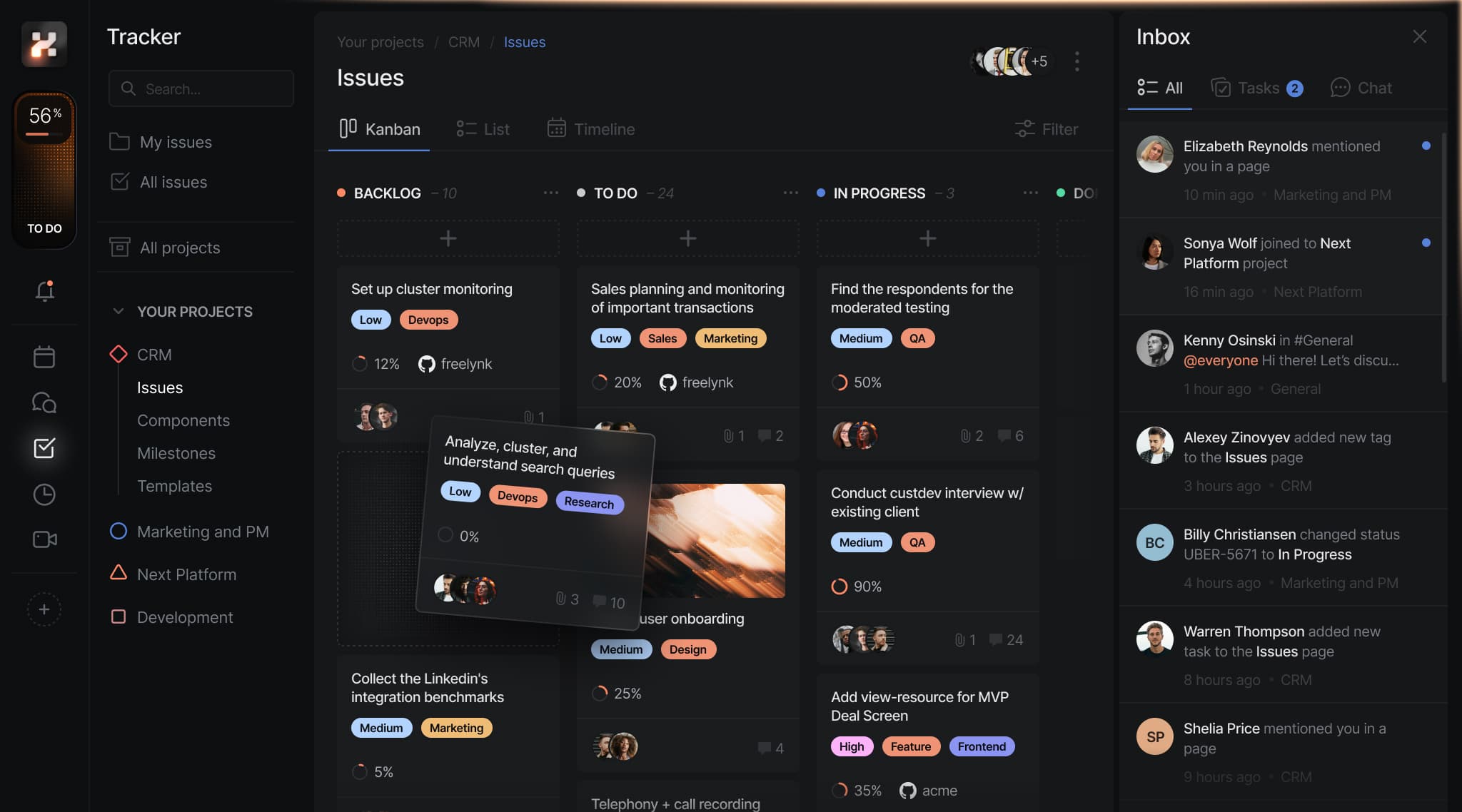What Is Huly.io?
Ever wished you could stitch projects, chat, meetings and docs into one tidy canvas? Huly.io does exactly that. The platform bills itself as an “everything app for teams,” unifying issue tracking, real-time chat, video calls, collaborative documents and time-blocking inside a single open-source workspace. Instead of shuffling between Jira for bugs, Slack for conversations and Notion for wikis, you point everyone to one browser tab. Huly.io ships with cloud hosting out of the box, yet the entire codebase lives on GitHub for teams that prefer to self-host and tinker.
Teams adopt it for two big reasons: first, the surface area is huge—planners, docs, virtual office, even AI transcription are included. Second, the pricing model is refreshingly simple: unlimited users on every tier, with a generous free plan that covers most small teams. In short, Huly.io tries to make context-switching obsolete.
Huly.io Key Features
Below are the headline capabilities that separate Huly.io from single-purpose tools.
Team Planner & Project Management
The left sidebar houses a Linear-style board where you group issues into cycles, drag tasks across columns and break roadmaps into milestones. Each card supports labels, story points, attachments and rich-text descriptions. A built-in calendar view turns those issues into time blocks, helping you visualise workload by day or week. Keyboard shortcuts keep power-users moving fast while notifications surface only what changes.
Virtual Office & Meetings
A click on the building icon drops you into a pixel-perfect “office” floor-plan. Teammates have personal offices (with knock privacy), dedicated team rooms for audio chats and full meeting rooms with video, screen-share and recording. Calls open in a docked sidebar, so you can browse tasks without losing eye contact. For deep focus you can pop the office into fullscreen. It feels a bit like Slack Huddles, Zoom and Gather, blended.
GitHub Two-Way Sync
Engineering squads will like the native GitHub connection. Map one or many repositories, then watch issues, pull requests and comments stay mirrored both directions. Create an issue in Huly.io and a matching ticket appears in GitHub; merge a PR on GitHub and its status flips in Huly.io automatically. You can even choose which repo a new card should land in.
Collaborative Documents
Huly.io ships a Notion-style editor with headings, inline code, tables and embeds. Multiple cursors dance in real time, so teammates see edits instantly. Because docs live beside tasks, you can mention an issue inside a spec or assign lightweight action items without leaving the page. Inline comments and version history arrived in the January 2025 update, making the editor viable for serious technical documentation.
Huly MetaBrain & AI Assistant
Meet Hulia, the resident AI assistant. Today she auto-transcribes meetings in multiple languages and saves the transcript as a searchable chat thread. Coming soon (the roadmap calls it MetaBrain) Hulia will summarise calls, draft action items, recall past decisions and surface recommendations from a “living memory” graph. The architecture, dubbed CollectiveCortex, treats every note, chat and task as an active memory that can spark related insights later. It is early, but exciting.
Pricing: Simple Tiers With Generous Free Plan
Huly.io keeps billing straightforward—every plan allows unlimited users and Huly objects. You only pay for resource ceilings.
- Common – $0/month. 10 GB storage and 10 GB video traffic per workspace. Ideal for small dev squads kicking the tyres.
- Rare – $19.99/month. 100 GB storage, 100 GB traffic. Great for freelancers or micro-agencies.
- Epic – $99.99/month. 1 TB storage, 500 GB traffic aimed at growing product companies.
- Legendary – $399.99/month. 10 TB storage, 2 TB traffic plus priority support for large organisations.
AI compute isn’t billed yet; once MetaBrain matures, Huly.io says costs will not exceed mainstream providers and you can even plug in your own OpenAI key.
All cloud workspaces start on the free tier and scale automatically, so there is no annual contract shock. If you prefer total control, a self-hosted Docker/Kubernetes package is available for zero licence fees—just cover your own infrastructure.
Frequently Asked Questions
Is Huly.io really free for unlimited users?
Yes. The Common tier supports unlimited teammates; you only hit a wall when your workspace crosses 10 GB storage or 10 GB monthly video bandwidth. Many early-stage projects never pay a cent.
Can I self-host Huly.io on my own server?
Absolutely. The source code lives on GitHub and the docs include docker-compose and Kubernetes manifests. You will need MongoDB, Elasticsearch and MinIO, plus optional services for AI and email, but nothing is licence-locked.
Does Huly.io replace Slack, Jira and Notion?
For many teams, yes. Issue tracking rivals Linear/Jira, chat threads behave like Slack channels, and the document editor offers the rich blocks people expect from Notion. Add a virtual office and you can comfortably sunset two or three subscriptions.
How secure is Huly.io for sensitive data?
Cloud workspaces run on isolated infrastructure with encrypted storage; self-hosted deployments put data entirely behind your own firewall. Role-based permissions, private projects and upcoming SSO integrations give admins granular control.
What is the roadmap for the Huly MetaBrain?
The next milestones are meeting summaries, automatic action items and proactive reminders. Longer term, Huly Labs is exploring the CollectiveCortex memory graph so Hulia can surface relevant documents or past discussions without being asked.
Huly.io is still young but already punches above its weight. If your team juggles three or more collaboration apps and you hate the swivel-chair routine, signing up for a free workspace—or spinning your own container—could shave hours off every week. Keep an eye on Hulia’s evolution; the moment automated summaries land, staying elsewhere might feel old-fashioned.


